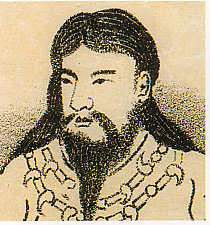Kaika
Kaika ( Japanese 開化 天皇 , Kaika-tennō ; * 208 BC ; † 98 BC ) was according to the old history books Kojiki and Nihonshoki the 9th Tennō of Japan (158 BC – 98 BC). ). Its historical existence is doubtful. He is one of the "eight undocumented emperors" ( 欠 史 八 代 kesshi hachidai ) of whom only a sketchy representation is known.
His proper name was Waka-yamato-neko-hiko-ō-hihi no mikoto (Nihonshoki (N): 稚 日本 根子 彦 大 日 日 尊 , Kojiki (K): 若 倭 根子 日子 大 毘 毘 命 ). His mother was Utsu-shiko-me no mikoto (N: 欝 色 謎 命 / K: 内 色 許 売 命 ). On the 14th day of the first lunar month in the 22nd year of reign (193 v. Chr.) His father Kōgen he was appointed at the age of 16 years for the crown prince and took over after his death two months later on the 12th day of the 11th lunar month in the 57th year of reign (158 BC) the throne.
Kaika ruled in the palace Izakawa (N: 春日 率 川 宮 , K: 春日 之 伊 邪 河 宮 , Kasuga no Izakawa no miya ) in Kasuga (probably in today's Nara ). His wives and children were (named in Nihonshoki and Kojiki, separated by a slash):
- Ika-ga-shiko-me no mikoto ( 伊 香 色 謎 命 / 伊 賀 迦 色 許 売 ), stepmother and wife
- Mimaki-iri-hiko-i-nie no mikoto ( 御 間 城 入 彦 五十 瓊 殖 尊 / 御 真 木 入 日子 印 恵 命 ), son and heir to the throne
- - / Mima-tsu-hime no mikoto ( 御 真 津 比 売 命 ), daughter, only Kojiki
- Taniwa-no-takano-hime ( 丹波 竹 野 媛 ) / Takano-hime ( 竹 野 比 売 ), concubine
- Hiko-yu-musumi no mikoto ( 彦 湯 産 隅 命 / 比 古 由 牟 須 美 命 ) or Hiko-mosu no mikoto ( 彦 蒋 簀 命 / 伊 賀 迦 色 許 売 )
- Hahatsu-hime ( 姥 津 媛 ) / Oke-tsu-hime no mikoto ( 意 祁 都比 売 命 ), concubine
- Hiko-imasu no miko ( 彦 坐 王 / 日子 坐 王 ), son
- - / washi-hime ( 鸇 比 売 ), concubine, only kojiki
- - / Take-tayo-hazura-wake no miko ( 建 豊 波 豆 羅 和 気 王 ), son, only Kojiki
He died according to the Nihonshoki at the age of 111 (a source also cites the Nihonshoki as 115 years) on the 9th day of the 4th lunar month in his 60th year of reign (98 BC), after the Kojiki at the age of 63. His mausoleum ( misasagi ) is the keyhole-shaped barrow Kasuga-no-izakawa-no-saka-no-e-no-misasagi ( 春日 率 川 坂 上 陵 , 'Imperial tomb on the hill of Izakawa in Kasuga'; 34 ° 41 ′ 0 ″ N , 135 ° 49 ′ 27 ″ E ) in Nara.
The name Kaika, whose characters mean 'civilization', was given later when the Japanese emperors began to give themselves Chinese, often Buddhist-inspired names.
Remarks
- ↑ In older literature also Kaikwa.
Individual evidence
- ^ A b c d William George Aston: Nihongi: Chronicles of Japan from the Earliest Times to AD 697 . Trench, Trübner & Co., London 1896, p. 148–149 ( Textarchiv - Internet Archive ). ; Copy of Nihonshoki (Japanese)
- ↑ a b c d Basil Hall Chamberlain: The Kojiki . 1919, Section LXII. - Emperor Kai-kuwa ( sacred-texts.com ).
- ↑ 天 皇陵 - 開化 天皇 春日 率 川 坂 上 陵 . Kunai-chō , accessed October 7, 2017 (Japanese).
| predecessor | Office | successor |
|---|---|---|
| Kōgen |
Tennō 158–98 BC Chr. |
Sujin |
| personal data | |
|---|---|
| SURNAME | Kaika |
| ALTERNATIVE NAMES | 開化 天皇 (Japanese); Kaikwa |
| BRIEF DESCRIPTION | 9. Tennō of Japan (158 BC – 98 BC) |
| DATE OF BIRTH | 208 BC Chr. |
| DATE OF DEATH | 98 BC Chr. |

